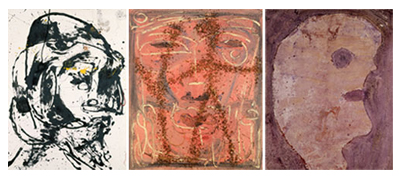
(left to right) Jackson Pollock, Number 7, 1952, 1952. Enamel and oil on canvas, 53 1/8 x 40 in. The Metropolitan Museum of Art, New York; Alfonso, Ossorio, Untitled, 1951. Oil and sand on Masonite, 30 x 27 in. Ossorio Foundation, Southampton, New York;Jean Dubuffet, L’Homme au nez menu (Man with Small Nose), 1950. Oil on board, 31 7/8 x 25 5/8 in. Courtesy Acquavella Modern Art, New York.
Jackson Pollock was born 100 years ago this year and, with an auction forthcoming in September of Red, Black, & Silver–an unauthenticated canvas attributed by some as the artist’s last painting–mythology continues to be made around his solitary, tragic, and oh-so-American brand of genius. Our upcoming exhibition, organized with the Parrish Art Museum in Water Mill, NY, tells a different story–one about Pollock’s important friendships and interest in the work of other artists in an international context. As its title suggests, Angels, Demons, and Savages: Pollock, Ossorio, Dubuffet (opening February 9) has three protagonists:
Jackson Pollock (1912-1956): The American painter, whose monumental drip paintings are among the most famous examples of abstract expressionism, met Alfonso Ossorio through gallerist Betty Parsons in 1949. In 1950 Pollock worked in Ossorio’s studio while Ossorio was in the Philippines painting a mural for his family’s chapel. It was at Pollock’s suggestion that Ossorio traveled that same year to Paris to meet Jean Dubuffet (Pollock himself would never meet the French artist in person).
Alfonso Ossorio (1916-1990): Born in the Philippines to a Spanish father and Chinese-Filipino mother and heir to a vast sugar fortune, his generous artistic patronage (he collected hundreds of paintings by his friends Pollock and Dubuffet) has come to obscure his own remarkable achievements as an artist.
Jean Dubuffet (1901-1985): The French painter and sculptor embraced the aesthetic of so-called “outsider art” imbuing his own work with what he perceived as its raw directness. He amassed an extensive collection of art brut, which Ossorio exhibited at his East Hampton estate from 1952 to 1961.
